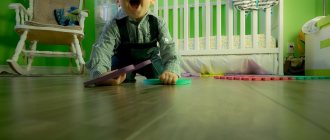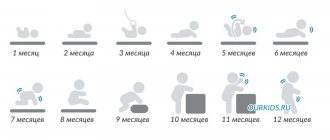Regimen for a child aged one to one and a half years
The daily routine of a child aged from 1 year to 1 year 6 months should provide sufficient sleep during the day, intervals between meals and periods of wakefulness that correspond in duration to the needs of the body of a child of this age. In addition to its enormous importance for the baby’s health, a correct, strictly followed regime is also important because it fosters discipline and eliminates the basis for a number of clashes between adults and the child.
When establishing a child’s daily routine, it is necessary to take into account his or her existing habits and needs. For example, it is more advisable to feed a baby under the age of one and a half years after sleep, then he will eat better. A well-rested and fed child is cheerful, cheerful and plays well. Having played enough, he will quickly and soundly fall asleep. Thus, the sequence: sleep, feeding, play and sleep again before feeding is the most rational, and should be maintained until the child switches to a one-time daytime nap.
It is possible to maintain such a correct sequence and not violate the regime if the child quickly falls asleep and sleeps for the entire set time, i.e., right up to feeding. If the child does not fall asleep for a long time and falls asleep only when it is time to feed, then, awakened by hunger and not getting enough sleep, he will become capricious while eating and the whole regime will be disrupted.
In order for the child to quickly fall asleep and sleep soundly, you should take him out into the fresh air during sleep and return from a walk to the time of feeding.
A one-year-old child can stay awake for 3 to 3.5 hours at a time. The period of wakefulness lengthens with age, and by the age of one and a half years the child may no longer sleep for 5 hours in a row.
From a year to a year and a half, the child’s routine is approximately the same as at 10 months, i.e.: at 8 o’clock. - breakfast, at 12 - lunch, at 16 o'clock. 30 min. - afternoon tea, 7 p.m. 30 min. - dinner; from 10 o'clock morning until 12 o'clock. day - first daytime nap, from 15 o'clock. until 16 o'clock 30 min. - second. Thus, at this age, children sleep 2 times during the day and eat 4-5 times. Night sleep should begin at 20 o'clock.
Weakened after illness or premature babies should sleep twice during the day until 1 year 8 months.
After a year, the child is usually no longer breastfed. If he turns one year old in the spring or summer, then he should not be weaned until the fall.
Some parents transfer their child to a one-time nap at the age of one, and not from one and a half years. At the same time, the child, although he sleeps once, sleeps for a long time - 3 hours in a row. This mode, of course, is convenient for adults, as it leaves more free time for homework. However, this is harmful for the child, because in this case he usually sleeps during the day from 10-11 o'clock. until 13-14 hours, and night sleep begins at 20-21 hours. Thus, between daytime and night sleep, the child is awake for 6-7 hours, which is tiring for him. In addition, in the evening, all the adults return from work, they talk and play with the baby, he becomes overexcited, and this has a very adverse effect on his nervous system.
When transferring a child to a one-time nap, parents often explain this by saying that the second time he falls asleep poorly and, obviously, a second nap is unnecessary for him. In reality, this is far from the case: it is nervous, excitable children, overloaded with impressions, who especially need a second sleep, who fall asleep poorly. Therefore, in order for them to quickly fall asleep, the necessary conditions should be created.
Doctors note that more often those parents who switched their children to a one-time nap schedule too early come to the consultation with complaints about “whims”, unbalanced behavior, and inexplicable crying of children.
++++++++++++++++++++++++++++++++++++++++++++++++++++++++++++++++
Daily routine for a child from 1 to 1.5 years old
A child up to one and a half years old will be less sick and tired if you choose the right daily routine for him and follow it. This regime is the basis for healthy child rearing. During this age period, the child’s nervous system is very unstable, so he needs to be given as much attention as possible. It is important for parents to know that a one-and-a-half-year-old and three-year-old child should live according to different sleep and activity patterns. During this period, you need to practice three different daily routines. We present the daily routine for a one- to one-and-a-half-year-old child.
The best daily routine
It will be considered optimal if the child’s daily schedule is designed in such a way that it coincides with his natural needs. If the child sleeps during the day at 13.00, then it is best to plan naps during the day at this time. If you suddenly change a child’s habits, his nervous system will suffer, and this daily routine will not bring any benefit. Therefore, the daily routine for a child aged 1-1.5 years should be as gentle as possible. Parents can judge the success of their regime by the child's good mood and good health.
The best daily routine is the one that accustoms the child to order and organizes his leisure time. Then it will be much easier for the child to get used to kindergarten and school.
If you don't follow a daily routine
If parents are illogical in observing the children’s daily routine, then they force the child to follow it, then they let everything take its course, this negatively affects the baby’s nervous system. He may have the following health problems.
- Moodiness, irritability, nervousness
- Fast fatiguability
- Changes in activity and rest
- Mood swings
- Lack of sleep, poor sleep
- Poor appetite
- Insufficient assimilation of information
- Reluctance to clean up after yourself or help your mother
Walks
It’s good to take walks with mom, dad, grandparents or other family members. The baby should see a friendly company. It is very important to take your baby to the playground when going outside. Communication with peers will not only improve social skills, but will also allow the child to actively develop his speech abilities.
Try to be in the fresh air for at least two hours a day.
My son loved to go for walks with his grandmother. She climbed into the sandbox with him and they built little beads together.
Age characteristics of a child 1-1.5 years old
When a child turns one year old, he begins to develop more rapidly than before. And at the same time, a child at this age still has many inconsistencies. Physically, the child is not yet able to withstand the whole day without sleep; he gets tired quickly. At the same time, the child loves to run and jump a lot and actively, however, he gets tired very soon and needs rest. The child’s coordination of movements is still insufficient, despite the fact that he wants to play for a long time and a lot.
A child at this age can fulfill an adult’s request to bring or serve something, and his active vocabulary begins to quickly expand. A child at this age throws away the pacifier and begins to eat with a spoon. True, it sheds a lot at the same time.
Useful tips for parents
To ensure your baby develops properly, try to develop responsibility and trust in your relationship. It would seem that at 1 year and 9 months the child is still completely stupid and understands little, but this is only in appearance. In fact, at this age, a child is quite capable of analyzing what happened and helping his parents. The main problem is the difficulty in concentrating on one thing for a long period of time. But at this age you can already begin to teach your baby to help around the house. For example, you can offer to help clean the apartment and collect your own scattered toys; over time, begin to teach your child to make the bed after himself. Even if it turns out badly, it is very important that the process itself takes place and the child feels like a full-fledged member of the family. In such a situation, the baby will begin to realize that mom and dad trust him, and he will gradually grow up. After all, these are exactly the thoughts that appear in a child’s head when they are assigned important tasks.
Try to make sure that at this age the baby already goes to the potty on his own; in any case, the child should not relieve himself. Show exactly where the pot is and how to use it correctly. Pay attention to how willingly the child carries out your instructions. Don’t be lazy to spend several hours or days so that some action is memorized and reinforced, because systematic repetition contributes to faster learning.
The development of a child at 1 year 9 months is distinguished by the peculiarity of acquiring new knowledge through one’s own trial and error. The baby touches everything with his hands, tastes everything, listens and sniffs. The child likes to analyze independently obtained information and share it with his peers in the process of communication.
- Physiology of children at 1 year 9 months
- Diet, sleep and rest patterns at 21 months of life
- Intelligence and psychology of children by 21 months
- Game activities
Features of child development at 1 year and 9 months
Sleep of a child 1-1.5 years old
Daytime naps should be scheduled twice in the schedule of a child of this age. The first time the child should sleep from two to 2.5 hours, and the second time - up to two hours.
In order for the child to fall asleep normally, you need to stop active games half an hour before. It is ideal if the child takes a walk with his mother in the fresh air an hour before bedtime. This way his nervous system will calm down, blood flow will be activated, and the blood will be more saturated with oxygen. It is very important that every day the sleep schedule, as well as other activities of the child, is planned at the same time. This way the child will develop habits and conditioned reflexes that will allow him to follow the schedule in the future and not disrupt his sleep and activity patterns.
When you teach your child to go to bed at the same time, you need to wake him up at the same time. True, it is permissible to “overstay” the baby for 15 minutes or wake him up a quarter of an hour earlier, if this is convenient for the child. After sleep, you need to start teaching your child to dress himself, helping him and showing him how to do it. At the same time, you need to show the baby the clothes and name them.
Sleeping in the fresh air is good in summer. In the cold season, before putting a 1-1.5 year old child to bed, you need to thoroughly ventilate the room. But the baby should not sleep in a draft - he will get sick.
Baby's sleep
At 15 months, a child can sleep once, twice, or three times a day. But still, most children go to bed no more than 2 times a day. It is advisable to combine it with time spent walking. Daytime sleep takes approximately 4 hours.
During the day, the little one sleeps up to 13 hours. At this age, almost all children experience uninterrupted night sleep.
It would be correct to observe certain rituals that foreshadow the early onset of sleep. For example, you can teach your child that before going to bed, he needs to carry out hygiene procedures and bathe. Or, after mom reads a fairy tale, it’s time to fall asleep.
When a child learns to fall asleep on time, most likely he will learn to wake up on time. If this is not the case, then the child can be woken up at certain hours. Over time, a habit will develop, and the baby will wake up at this time.
We must not forget about what the optimal temperature and humidity should be in the room in which the baby is resting.
It is important that the child is not present during the day during scandals and when the TV or computer is turned on around the clock. All this will negatively affect the baby’s healthy and uninterrupted sleep.
How many times should I feed a child aged 1-1.5 years?
Feeding should not be less than four times a day. Approximately 3-4 hours should pass between feedings. After feeding, the baby should take a walk. And then you can get some sleep, and after sleep the baby is fed again. With this daily routine, the child grows and develops well. After sleeping and eating, the child is calm, plays well, is not capricious, his nervous system is calmer than those of those children who do not get enough sleep and are malnourished.
When you spoon feed your baby and teach him to use this device on his own, you can use a little trick. If a child cannot eat from a spoon, you need to put thick food into it first, and then, when everything starts to work out, you can scoop out liquids with a spoon: soup, jelly. There is no need to overexert the child: let him learn just a little, 3-4 spoons are enough, and then dad or mom will feed the baby. At the end of feeding, you can use a bonus for the baby - allow him to finish himself with a spoon when there is very little food left.
Sleep in young children (1-3 years)
What can parents expect?
The daily sleep duration of young children averages from 12 to 14 hours. By 18 months, most young children spontaneously establish their own sleep schedule, which includes an afternoon nap of 1.5 to 3 hours. Sleep duration varies from child to child, but parents should expect it to be consistent and consistent. Sleep duration can be disrupted by illness, stressful events, and changes in daily routine. The appearance of anxiety in a child, especially if he is separated from his mother, can also affect the quality of sleep. Most young children are transferred from their crib to their own bed by their parents between the ages of 2 and 3 years. If a child is put to bed at an earlier age, this event can also lead to sleep disturbances.
Many children continue to wake up in their sleep, although in most cases the awakenings are due to the lack of a strict daily routine. All children wake up in their sleep for a very short time. However, children who have not developed the habit of falling asleep on their own are unable to fall asleep without the help of their parents.
How can you help your child sleep well?
- Stick to a strict daily routine. The child should fall asleep at the same time day and night and get adequate sleep at night. If a child wakes up late after a nap, it will be difficult for him to fall asleep at night. Try not to deprive your baby of naps during the day if you want him to sleep well at night, as a tired baby will have a harder time falling asleep at night.
- Use toys that allow your child to relax. Give preference to simple and discreet soft toys (bears, dogs) that will allow the child to feel comfortable and calm.
- Set a daily routine. Games should be calm and enjoyable for the child. Taking a bath and telling stories should be short. Always turn off the lights in your child's room before leaving.
- Organize consistency in your child's sleep conditions. Make sure that the conditions in which your child sleeps are comfortable. A child sleeps best in a cool, dark room, in a calm environment.
- Put your child to bed sleepy, but not awake. This tactic will help your child fall asleep on his own and form the habit of calming himself down when he wakes up in the middle of the night.
- Follow strict time limits when organizing your bedtime routine. If your child cannot sleep and gets up in the crib, try to limit his behavior. For example, determine the number of fairy tales or books you read. Approach your child a certain number of times after you put him to bed.
- Contact your doctor if:
- the child has breathing problems, namely noisy breathing, snoring, breathing with an open mouth, daytime sleepiness; symptoms of hyperactivity, impaired attention and impulsivity (Questionnaire for parents of children with apnea);
- if your child has night terrors or unusual awakenings during sleep; (night terrors)
- if your child cannot fall asleep for a long time (more than 40 minutes - 1 hour) or has problems with the quality of sleep that affect his daytime behavior - hyperactivity or drowsiness, morning headaches.
In all cases, a consultation with a somnologist and a polysomnographic study is necessary.
Activity of a child 1-1.5 years old throughout the day
As we have already figured out, the baby sleeps for about 4-4.5 hours during the day. The same amount of time is spent on the period of activity. Changing the daily routine, that is, reducing the period of sleep or period of activity, should not be done, because this may have an undesirable effect on the child’s health. The child may suffer from increased fatigue or, conversely, lethargy.
To make the child’s activity more varied throughout the day, it is necessary to include bathing and educational games in the daily routine. Books, bright toys, pyramids, cubes are a very good way to diversify the waking period of a child aged 1-1.5 years.
How to determine that a 1.4 year old child is not sleeping well and what to do about it?
Some parents take general sleep standards too seriously and begin to worry at the slightest deviation from them. Of course, you shouldn’t do this, because, as was said earlier, the duration of rest is a very individual matter.
However, there are certain signs that a 1.4-year-old child does not sleep well at night or during the day, which means he does not get enough sleep. In particular, the following conditions should be on your guard:
- The baby instantly falls asleep at any opportunity: in a stroller, car, in your arms, under your breast or with a bottle. A well-rested 16-month-old baby should remain awake for at least some time in such circumstances;
- the morning independent rise shifts to later and later times, sometimes the child even has to be woken up;
- the child is capricious for no reason during the day, refuses to play and generally looks tired;
- once every 3-4 days the baby “passes out” at night earlier than usual;
- a 16-month-old child often wakes up and cries in his sleep;
- waking up too early in the morning: childhood insomnia can also be a sign of prolonged sleep deprivation.
In such situations, measures should be taken: change your daily routine, increase the duration of your stay in the fresh air and the volume of outdoor games, perhaps even seek advice from your pediatrician, since sleep problems may be a symptom of a particular disease.
If all these signs are absent, but it seems to you that the child is sleeping less than he should, calm down: it just seems to you. Such deviations are physiological and can be associated both with a genetic predisposition to short sleep and with how active your baby is mentally and physically during the day.
Bathing and hardening
Before afternoon tea you need to give your child a bath. If not bathing, then rubbing, it is also very useful for hardening. First they wipe the child's arms, then the chest, then the legs, then the back. The water temperature should be no higher than 35 degrees Celsius. To harden a baby under the age of one and a half years, you can gradually reduce the water temperature. Once a week or five days, when bathing and drying, reduce the water temperature by 5 degrees, resulting in a water temperature of 24 degrees. You should not give up hardening - it greatly strengthens the child’s nervous, immune and respiratory systems.
What should you teach a 1-1.5 year old child?
At this age, it is imperative to teach your child to wash his hands, brush his teeth, and use a spoon, napkin, and potty.
Daily routine for a child from 1 to 1.5 years old
| Kind of activity | Time |
| Feeding | 7.30, 12.00, 16.30, 20.00 |
| Wakefulness | 7.00 – 10.00, 12.00 – 15.30, 16.30 – 20.30 |
| Dream | First sleep – 10.00 – 12.00, second – 15.30 – 16.30, night sleep – 20.30 – 07.00 |
| Walk | after lunch and afternoon tea |
| Bathing | 19.00 |
Intellectual development
Gaming activity gradually becomes dominant. The toddler observes his surroundings and imitates the daily activities of adults in the game (hanging out laundry, talking on the phone, picking up a fallen doll and rocking it to sleep).
Socialization gradually occurs. The baby plays next to other children on the playground or in the sandbox. This is not a joint game yet, but a side-by-side game.
At this age the baby:
- knows his name;
- admires his reflection in the mirror;
- to the question “who is that in the mirror? » calls himself by name;
- knows where he lives, can lead his mother from the place of walking to the house;
- tries to obey the instructions “you can’t” and “you can”;
- performs simple tasks (bring a toy, give a spoon);
- shows primary colors - red, blue, yellow, green;
- distinguishes between sizes - large and small;
- distinguishes the simplest shapes (circle, square);
- builds simple structures from cubes (tower, gate, road);
- concentrates attention on an object for 3 – 10 minutes;
- assembles a puzzle of 2-4 parts;
- shows parts of the body - arm, leg, head;
- shows parts of the face - nose, eyes, mouth;
- sorts items in a sorter;
- loves to “read” books.
The best games are active and emotional. My favorite is hide and seek. Both an adult and a child can hide. How happy the baby is when he realizes that he has been “discovered.”
Among the great variety of toys and educational games for intelligence, we can highlight:
- sorters,
- constructors with large parts,
- simple puzzles,
- large puzzles from 2 – 4 parts,
- nesting dolls, tumblers,
- cars, tractors, locomotives and other vehicles,
- figurines of animals, fairy-tale characters,
- mechanical spinning top (top),
- magnetic fishing,
- large mosaic,
- lotto,
- paired pictures.
2.1. Productive activity
A child of the second year of life should be taught to display on paper everything that he sees in life. Even if these are primitive works for now, but how interesting it will be to look at them when the baby becomes an adult!
Recommended themes for paintings:
| Subject | Image | What do we draw with? |
| Nuts for squirrels | Next to the image of the squirrel we draw nuts. | Foam sticks, gouache |
| Tracks horizontal | Horizontal lines along which chickens (hens, birds) will then run. An adult will place the chickens on the paths | Pencils |
| Rain | Vertical abrupt lines. We draw and say: “Rain and rain, drip and drip, wet paths. We can’t go for a walk, we’ll get our feet wet.” | Markers |
| Flower glade | We draw many flowers on green cardboard | Gouache, watercolor, fingers, cotton swabs |
| It is snowing | Draw snow flakes on a dark background | Gouache or watercolor, foam sticks |
| Sprig of currant (rowan) | Draw berries on a leaf with a green branch | Gouache, fingers |
| Winter patterns on the window | Draw patterns on a blue background | Wax crayons |
| The Christmas tree came to visit | Add colorful balls to the Christmas tree | Watercolor or gouache, with fingers |
| Decorating a dress for a doll | On a dress cut out of paper, add stripes, spots, strokes | Watercolor, brush |
When working with paints, you should not forget about jars - sippy cups, napkins and other means that will help in case of minor troubles.
ADVICE FOR PARENTS. When drawing, do not forget to pronounce the names of the colors. Teach your child to clean up after himself after class. And be sure to praise the artist after completing the masterpiece.
During modeling lessons, the child learns to tear small pieces of clay (plasticine) from a whole piece (crumbs for a titmouse), flatten flat cakes (pancakes for grandma), and poke holes in a layer of clay with his fingers (holes for a mouse).
When doing applique, you need to teach your child how to position the glue stick correctly, perpendicular to the paper, and carefully smear the silhouettes that need to be pasted. At first these are figures randomly located on the sheet. And then you can come up with a plot (a Christmas tree with lanterns, a caterpillar made of multi-colored circles, a house made of squares).











